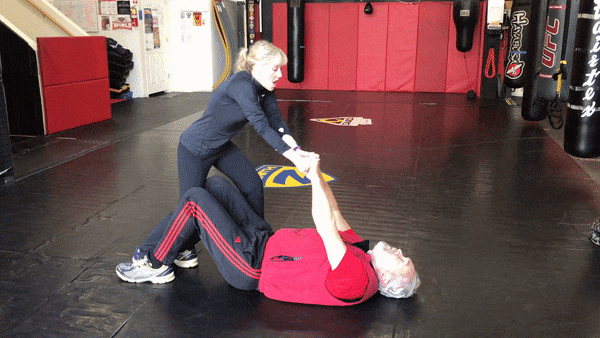
When someone falls, our first instinct is to help them up quickly. We usually do so without thinking about our own back. People typically don’t fall in a convenient place or perfect position. Many times it’s in a shower or tub, by a bed wedged between a nightstand, or even in a closet. If your loved one is twice your size and has Parkinson’s, it could be hazardous to you if you try to lift them.
- When a person falls the first thing you do is WAIT. Even if they try to get up by themselves, ask them to wait and assess the situation. Did they hit their head? Did they break anything, a hip, a wrist? This will give them time to regain control of their body after the stress of a fall.
- If they are injured (such as a neck or broken hip) DO NOT ATTEMPT TO MOVE THEM! Make sure they can breathe comfortably, call 911, and cover their body with a blanket to keep warm to help avoid shock.
- Assuming they are not injured, get an object they can climb up on (like a sturdy chair without wheels) and place it at their head.
- If they are on their back, get on their strong side. They may be right-hand dominant making that the strong side. Or the opposite side may be affected by PD, an injury, or frozen shoulder. Help them roll towards the affected or weak side.
- Tell or assist them to bend their strong-side knee and bring it across their body towards the weak side.
- Tell or assist them to reach with the strong arm in the same direction.
- Instruct them to “log roll” towards their weak side. You can push their hips from behind to get them over. You should be kneeling. Being bent over may hurt your back or you could fall forward. Keep encouraging them to get on all fours. This may take time, and you can keep nudging them until they get that trapped arm freed.
- Have them put both hands (or elbows) on the chair starting with the strong arm. You may need to help them lift their other arm.
- Have them rest in this position if they need to as the next step takes some effort. You can give them a drink of water, or let them hang out in this assisted kneeling position. It’s a good time to regroup.
- To get up on the chair, they need to bring the strong leg forward to the side of the chair in a half-kneeling position. This may be inching it forward in many little steps. Point to where they should place their foot, it will help them focus. Again, rest if needed.
- If you can, grab their waistband or use a gait belt to assist them in the chair. I’m stressing the word “assist”. Most people helping do a lot more lifting than needed, and can strain their back. Be sure to bend at your knees (instead of your back). Make it very clear they should push themselves up and you will help a little. You should not lift their weight by yourself.
- Instruct them to maneuver around, sit in the chair, and stay there for several minutes.
- If after a few tries you cannot do it safely, you should get help. Call someone. If you hurt your back, it will make everything that much worse.
Practice, practice, practice! If you practice this, it will become automatic in the case of a fall. Your brain and nervous system will go into recovery action instead of panic mode, which will further deplete your energy. It’s a great team building exercise!
